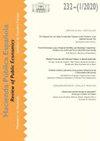大流行后世界的房地产:政策如何使住房更具环境可持续性和可负担性?
IF 0.5
4区 经济学
Q3 ECONOMICS
Hacienda Publica Espanola-Review of Public Economics
Pub Date : 2023-03-01
DOI:10.7866/hpe-rpe.23.1.5
引用次数: 0
摘要
包括住宅和商业市场在内的房地产行业是能源消耗大户,因此也是温室气体排放的重要来源。这主要是由于加热和冷却系统以及家用电器的使用消耗了能源。建筑的建造、维护和热特性增加了该行业的能源消耗。基于对学术和政策工作的回顾,本文认为,实现商定的气候变化目标的脱碳战略将需要纳入针对房地产行业特殊性的政策。这些措施包括解决自住者、房东和租房者(在私人和社会住房市场)在家庭改善和能源改造投资方面的分散激励;透过标签/认证及其他方法,提高新建及现有物业的能源表现标准;降低所需投资的融资成本,同时扩大服务不足人口的服务范围。本文章由计算机程序翻译,如有差异,请以英文原文为准。
Real Estate in a Post-Pandemic World: How Can Policies Make Housing More Enviromentally Sustainable and Affordable?
The real estate sector, including the residential and commercial market segments, is a heavy consumer of energy and, as a result, a sizeable source of emissions of greenhouse gases. This is primarily on account of the consumption of energy in heating and cooling systems, as well as in the use of domestic appliances. The construction, maintenance and thermal characteristics of buildings add to the sector’s energy consumption. Based on a review of scholarly and policy-focused work, this paper argues that decarbonisation strategies to meet agreed climate change targets will need to incorporate policies targeted to the specificities of the real estate sector. They include addressing split incentives among owner-occupiers, landlords and renters (in the private and social housing markets) for investment in home improvements and energy retrofitting; raising the standards of energy performance for new and existing properties through labelling/certification and other means; and reducing the cost of finance for needed investments while broadening access to the underserved population.
求助全文
通过发布文献求助,成功后即可免费获取论文全文。
去求助
来源期刊

Hacienda Publica Espanola-Review of Public Economics
Economics, Econometrics and Finance-Finance
CiteScore
0.90
自引率
14.30%
发文量
14
期刊介绍:
Hacienda Pública Española/Review of Public Economics welcomes submissions on all areas of public economics. We seek to publish original and innovative research, applied and theoretical, related to the economic analysis of Government intervention. For example, but not exclusively: Taxation, Redistribution, Health, Education, Pensions, Governance, Fiscal Policy and Fiscal Federalism.
In addition to regular submissions, the journal welcomes submissions of:
-Survey Reviews, containing surveys of the literature regarding issues of interest in the Public Economics field;
-Policy oriented reviews, showing the current contributions of Public Economics in relation to relevant contemporary issues affecting public decision-makers in the real world (Policy Watch);
-Comments of previously published articles. Contributions to this section should be limited to a maximum of 2 000 words (12 pages). If deemed adequate, the authors of the commented article will be given the opportunity to react in a Reply. Both Comment and Reply will be published together.
Articles for the Survey Reviews and Policy Watch section are subject to the same double blind reviwing procedure. The adequacy of Comments submitted for publication will be evaluated by the Executive Editors.
 求助内容:
求助内容: 应助结果提醒方式:
应助结果提醒方式:


